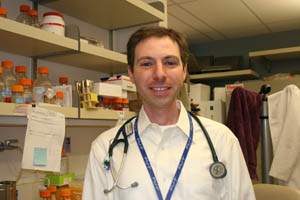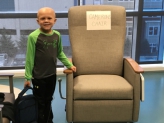Comprehensive Analysis of Risk Factors for Pediatric Cancers Using the Utah Population Database

Over 12,000 children and teenagers are diagnosed with cancer every year in the United States. Physicians and researchers know that a small percentage of these cancers are due to environmental exposures and genetic susceptibility (hereditary cancer syndromes), but the cause of nearly 90% of these cancers remains unknown. Dr. Schiffman received an Alex's Lemonade Stand Foundation Epidemiology Award for his work to identify risk factors that can help scientists to predict and understand the causes of childhood cancer. To do this, Dr. Schiffman (a pediatric hematologist/oncologist) is taking advantage of an ongoing population resource called the Utah Population Database (UPDB). This shared resource located at the University of Utah consists of computerized data records for over 6.5 million individuals. It is the only database of its kind in the United States and one of a few in the world; most families living in Utah are represented in the UPDB. Nearly 70% of subjects have five or more previous generations recorded in the UPDB, and it is not unusual to find families with over 20,000 relatives in the UPDB. The UPDB includes vital records for births and deaths from the early 1900’s, drivers license and voter registration records, statewide hospital records, and is linked to comprehensive Surveillance Epidemiology and End Results (SEER) Utah Cancer Registry records. The UPDB allows cancer researchers like Dr. Schiffman to ask very focused questions about risk factors related to diseases, in this case, pediatric cancer.
Dr. Schiffman's study is using the UPDB to investigate the correlation between birth factors and pediatric cancer risk in Utah, to identify pediatric cancers clustered within families, and to study patterns of childhood and adult-diagnosed cancers that may indicate new hereditary cancer syndromes. Dr. Schiffman's group initially classified potential risk factors available through the UPDB into five different subgroups, which include: 1) neonatal characteristics, 2) maternal characteristics, 3) pregnancy complications, 4) complications of labor and delivery, and 5) abnormal conditions of the newborn. In order to validate their study, Dr. Schiffman first assessed whether these specific risk factors were similar to the existing literature. Their initial positive findings led to the assessment of other potential risk factors that have been rarely studied and they found several factors that significantly increased the risk of pediatric cancer. According to their results, an infant born with a low Apgar score or an expectant mother with pre-eclampsia are just two examples of factors that may increase the risk of pediatric cancer development. For the familial investigations, Dr. Schiffman's group identified 4,092 pediatric cancers cases (1,337 diagnosed under age five) in the UPDB with enough family data available for analysis. Familial relative risk ratios (RRs) were estimated for each case and Dr. Schiffman discovered that family members (first- or second-degree relatives) of pediatric cancer cases have a 3.6-fold increased relative risk of being diagnosed with cancer themselves, as a child or young adult, compared to population-based matched controls. First-degree relatives, predominantly siblings, exhibited a 4.5-fold risk of cancer diagnosed prior to age 30, which increased to almost 6-fold risk if the initial pediatric cancer in the family was diagnosed before the age of 5 years old. Adult relatives of pediatric cases appear to have an excess risk of older onset cancers which may be related to an underlying genetic predisposition such as Li-Fraumeni syndrome (TP53 mutations). Dr. Schiffman is now trying to understand if the increased pediatric cancer risk they observed in other relatives is also due to hereditary cancer syndromes. He also is exploring whether clinical outcome is affected based on having other relatives with cancer.
Dr. Schiffman's findings will contribute to the field of childhood cancer and epidemiology. His group has made some unique discoveries related to gestational and post-natal risk factors. These risk factors differ by cancer subtype and therefore may help to shed light on the unique biology of tumorigenesis for different childhood cancers. They also found a significant increase in 1st and 2nd degree relatives of children with cancer (and this familial risk was greatest if the original diagnosis was found in the youngest children with cancer in the UPDB). This suggests a genetic component to these increased familial risks for cancer. If Dr. Schiffman and others can identify the genetic causes for these cancer risks, then cancer prevention strategies may one day be able to be introduced for high risk children. As part of Dr. Schiffman's analysis, he has established a "Cancer Genetics Study (CGS)" at the University of Utah to enroll and explore the DNA of these high risk children for whom he cares. Together with the UPDB data, this will help increase our understanding of the genetic causes of pediatric cancer. Dr. Schiffman is grateful to Alex's Lemonade Stand Foundation for funding this type of research which hopefully will increase our knowledge of why children develop cancer and one day may even lead to its prevention.
Update
Joshua Schiffman also received a 2012 Epidemiology Award.

